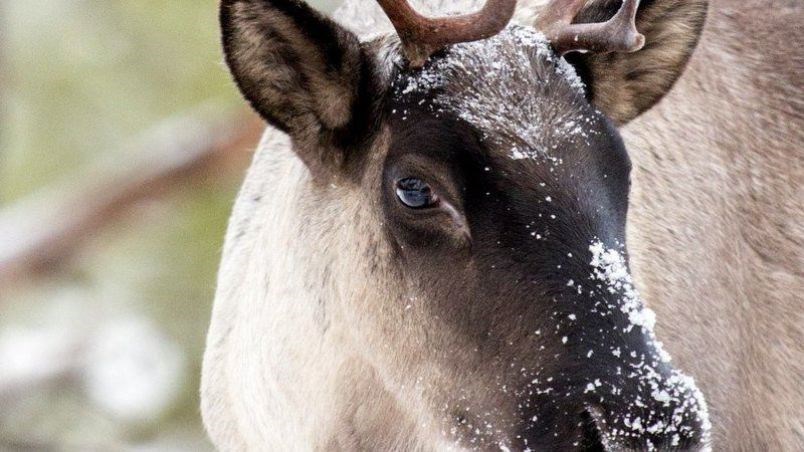A new report was released this week to address declining caribou populations.
The new report was put out by the forest industry.
It may have followed that a forest sector examination of a woodland animal might have hinted at environmental protection tactics that somehow still permitted unfettered logging. Not so. In fact the document entitled Forest Sector Contributions To Woodland Caribou Recovery called for stepping up whatever measures were necessary to bring this species - with endangered herds in multiple regions around Prince George - back from the edge of extinction.
Published by the Forest Products Association of Canada (FPAC), it urged all levels of government to invest in new science, accept more input from people working out on the land, and accept historic Aboriginal accounts of wildlife trends dating back prior to written history.
The reasons for the ecological endorsement is perhaps not expected, said FPAC chief executive officer Derek Nighbor, but healthy forests are profitable forests, and conscientious business practices make Canadian wood products a better buy on the world market.
"Canada's forests and forestry workers create real environmental, social, and economic opportunities for our country," said Nighbor. "This report and its recommendations reflect an ongoing commitment from the dedicated professionals in our sector to work with all levels of government, Indigenous communities, researchers and scientists, and local community groups to support caribou recovery across Canada."
In an exclusive conversation with The Citizen, Nighbor said the national forest industry has already done this kind of thing before, helping the Vancouver Island marmot to climb exponentially higher from critical population lows, and the sector is also advocating for other species like the marbled murrelet, northern goshawk, the barn owl and several others.
"All of this stuff is really connected," Nighbor said. "We are an industry that plans in 100- to 200- year cycles for harvesting, and we develop five-year and 10-year plans within those larger plans. We in the forest sector need to know where the wetlands are, where are the eagles nests?, where are the bear dens?, and where are the caribou? We need to be out in front of that, and we are out on the land, we are close to all those values that are connected to our harvest and reforestation values. You have multiple interests all on the same landscape and we want to see government policy that is based on the very best possible science. We don't want to create ecological victims and we don't want to be the industrial victims of bad decisions. We are an industry that has the ability to be flexible to the needs of the ecology, we know it is important to our customers around the world, and we know it's the law. We just want - for everybody's sake - to be operating under the best possible data-sets."
Operational decisions should be researched carefully to anticipate its ripple effects, said Nighbor, and that includes the decisions to log a certain area or what silviculture should be done, where to build a resource road or where to clear a landing. That applies as well to ecological tactics on behalf of endangered species.
"It's important to not end up doing more damage to the ecology due to unintended consequences of very noble intentions, and on the industry's part we need to consider that just because we've done things a certain way up to now, that that can continue without dire consequences. We all have a role to play, we all have our impacts, and the best way to go forward is with strong science and strong dialogue with those people who have regional knowledge."
Nighbor said it wasn't lost on the industry that more pressure was put on these issues by fire than by forestry. Getting a handle on shutting down wildfires before they balloon into Shovel Lake or Verdun Mountain or Elephant Hill would help the industry be better resourced to help the endangered caribou and other species under threat.
"We have lost 20 times the amount we harvest to fires and pests. If that's not a call to action...
And B.C. is ground zero for a lot of this stuff," Nighbor said.
The ferocity of the modern forest fire is a symptom of global climate change, he said, and that is having a profound impact on the entire ecosystem where forest works do their work. It has changed hydrology, growth periods, species patters, animal migrations, plant life, and will also change forest policy. Nighbor said investing in caribou protections, especially the research needed, would also help inform overall knowledge of the changing Canadian forest and how to it could be better managed.
"Caribou recovery planning is one part of this important web of work we undertake in our forests every day," said Nighbor. "This report provides insights into a number of the activities that are making a difference in supporting caribou recovery while recognizing it is important to find solutions that consider all wildlife species living in our forests, including caribou. Our made in Canada approach to forest management is rooted in planning for the entire ecosystem which will help us keep our forests healthy for generations to come, and will help us sustain rural and northern communities and family-supporting jobs across Canada."
The full Forest Sector Contributions To Woodland Caribou Recovery report can be found at the Citizen's online version of this story.
FOR THE WEB:
Forest Sector Contributions To Woodland Caribou Recovery report can be found here: https://www.fpac.ca/forest-sector-contributions-to-woodland-caribou-recovery/

.png;w=120;h=80;mode=crop)

